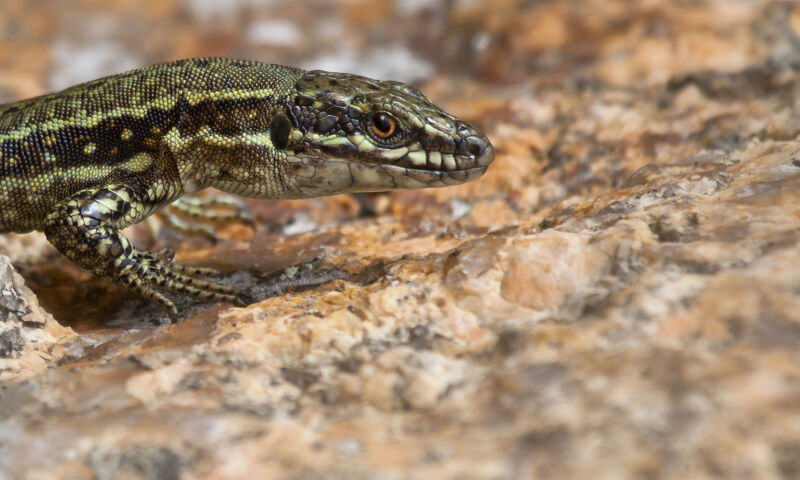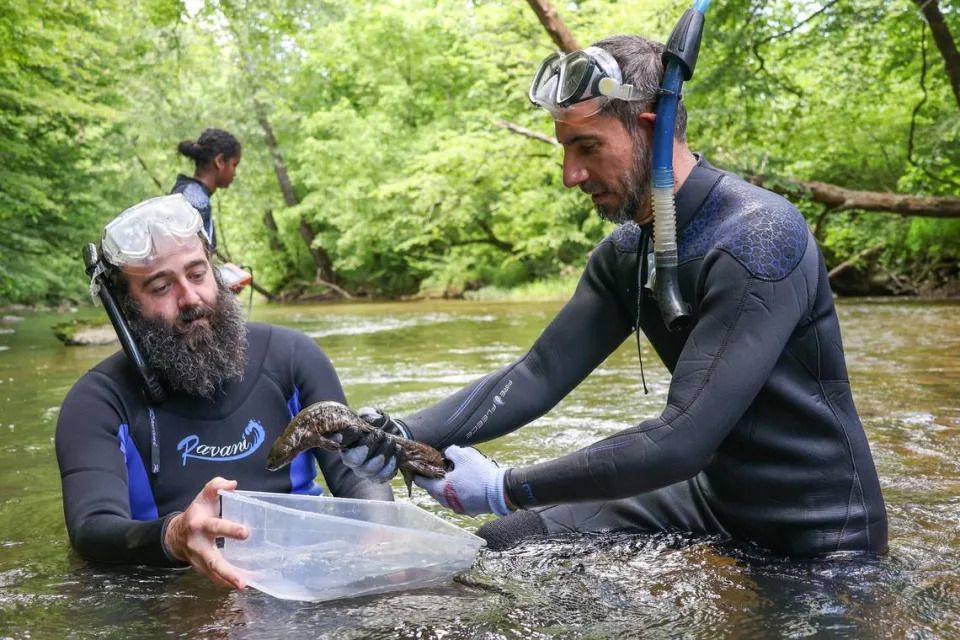Lizard that Hulks out shows off its superhero genes
A subspecies of reptiles in Italy is much bigger and greener than its relatives.
ELIZABETH RAYNE - 5/22/2024, 1:31 PM

Enlarge
Kristian Bell8
The lizard Podarcis muralis nigriventris might not grow to a freakish size and smash everything in sight, but evolution has turned this lizard into the Incredible Hulk of sorts—green skin included. P. nigriventris is something like the imposing Marvel superhero when compared to other strains of common wall lizards (Podarcis muralis). While the common version tends to be relatively small and brownish to greenish-brown, the nigriventris subspecies, which is found in central Italy, is visually impressive because of its green(er) skin with black markings, larger size, and heightened aggression.
A team of evolutionary biologists led by Nathalie Feiner of Lund University in Sweden decided to find out which genes contributed to making P. nigriventris so Hulkish. Like many fictional humans with superpowers (but unlike the mutant Hulk), this lizard is a hybrid
Hulking hybrids
Though common wall lizards are found from the Iberian peninsula all the way to Asia Minor, the researchers focused on lizards from populations in central Italy (IT lineage) and the southern Alps (SA lineage). These lineages most likely diverged from a common ancestor between 5–6 million years ago and then began to hybridize—individuals from the different lineages mated with each other to produce hybrid offspring.
P. nigriventris originated as a subspecies of the IT lineage. However, some of its features were passed on from the SA lineage. This is called introgression, which occurs when genetic information is transferred from one lineage or species to another as the result of hybridization. The traits that the researchers focused on were coloration on the back and stomach, lateral blue spots, body mass, and head length.
Because P. nigriventris traits have made their way into the SA lineage through introgression, it can be difficult to tell what’s truly ancestral. It was first assumed that females selected for P nigriventris features in males, which increased their chances of finding a mate. However, some of those features were later seen in females, so these traits are not exclusive to males competing for females.Advertisement
“Different lines of evidence support the existence of [these traits] in both sexes, and [the traits] remain intact during introgression into a distantly related lineage,” the researchers said in a study recently published in Science Advances.
The brownish P. muralis are considered to be the ancestral phenotype. To see how the nigriventris phenotype arose, Feiner would need to find where the traits that make up this phenotype were located in the lizard’s genome.
Green genes
What Feiner and her team discovered while analyzing the lizards’ genomes was that the features that make P. nigriventris stand out are determined by genes that regulate neural crest cells. These multipotent stem cells, which form during an early embryonic phase, can morph into different types of more specialized cells throughout the embryo, contributing to everything from heart valves to coloration.
One such gene, Rbm10, regulates the proliferation of neural crest cells, meaning their growth and division, while another, Tfcp2l1, regulates how they differentiate into more specialized cells as the embryo develops. Yet another, Gpc3, is needed for neural crest cells to migrate to different places in the embryo where they integrate into tissues.
But where was the difference that would ultimately alter the coloration of nigriventris phenotype? The answer was in a region of a chromosome that contains a gene, known as Rab18, which also helps with the migration of neural crest cells. Rab18 and Acbd5 both have a role in pigment production. This could be related to the green and black coloration of P. nigriventris.
“Analyses of gene flow revealed that this [chromosomal] region likely introgressed from the IT lineage into populations of the SA lineage that strongly express the nigriventris phenotype,” the researchers said in the same study.
While the exact factors that caused these green and black P. nigriventris monsters (at least monsters next to their P. muralis relatives) to evolve differing colorations in order to adapt to changes in their environment are still unknown, where their looks come from is no longer a mystery.
At least Hulk-ified lizards don’t have to expose themselves to extreme radiation to get their size, color, and strength, unlike Bruce Banner himself.
Science Advances, 2024. DOI: 10.1126/sciadv.adk9315
Watch skin-breathing hellbenders — largest salamanders in the US — return to the wild
Olivia Lloyd
Fri, May 24, 2024
Standing in a stream wearing snorkel gear and gloves, hellbender conservationists scooped the wriggly salamanders out of their bins and deposited them under suitable rocks underwater.
The team has introduced more than 100 creatures to Middle Tennessee waterways since the start of a program to revitalize the endangered hellbender population in the state, the Nashville Zoo said May 23.
With the latest release, 27 of those hellbenders are back home.
The salamanders were taken from the wild as eggs and brought to the Nashville Zoo to hatch and grow. The zoo has been collecting eggs since 2018, and these salamanders are the fourth group released back into the wild since 2021, according to conservationists.
\“We’re honored to help this state-endangered salamander species and work to strengthen their population in the wild,” zoo officials said in the release.
Eastern hellbenders are the largest species of salamander in the Americas, ranging from 12 to 29 inches long and weighing up to 5 pounds, according to the Smithsonian’s National Zoo.
This type of aquatic salamander lacks gills as an adult and instead absorbs oxygen through its skin.
“Early settlers thought that these strange looking animals looked like creatures from Hell that were ‘hell bent’ on returning and thus, the common name Hellbender,” according to the Virginia Department of Wildlife Resources.
In addition to its common name, the salamanders are sometimes called snot otters.

The hellbender conservation team brought the salamanders from
Nashville Zoo to waterways in Middle Tennessee for their release.
The zoo has been experimenting with different methods of maintaining a genetically diverse population.
In 2012, the zoo bred two captive hellbenders using artificial fertilization, and in 2015, conservationists hatched a hellbender from an egg that was fertilized with cryopreserved sperm.
“We can maintain that genetic diversity with a lot fewer animals and a lot fewer resources,” according to Dale McGinnity with the Nashville Zoo. “That’s why we’re really excited about developing these techniques.”
Species preservation efforts for the big salamanders have been in the works in other states as well. In 2022, Missouri conservationists released their 10,000th hellbender into the wild, McClatchy News reported.
The Nashville Zoo worked with the Tennessee Wildlife Resources Agency and Tennessee State University.
The zoo has been experimenting with different methods of maintaining a genetically diverse population.
In 2012, the zoo bred two captive hellbenders using artificial fertilization, and in 2015, conservationists hatched a hellbender from an egg that was fertilized with cryopreserved sperm.
“We can maintain that genetic diversity with a lot fewer animals and a lot fewer resources,” according to Dale McGinnity with the Nashville Zoo. “That’s why we’re really excited about developing these techniques.”
Species preservation efforts for the big salamanders have been in the works in other states as well. In 2022, Missouri conservationists released their 10,000th hellbender into the wild, McClatchy News reported.
The Nashville Zoo worked with the Tennessee Wildlife Resources Agency and Tennessee State University.
No comments:
Post a Comment